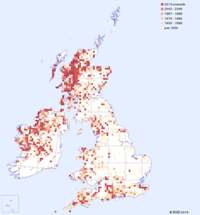Unlike the Greater Butterfly-orchid, which is localised throughout the UK and Ireland, the Lesser Butterfly-orchid is classified as vulnerable. Both species are in steep decline due to habitat destruction, agricultural pollution and the replacement of ancient woodlands with conifer plantations. They both flower between late May and early July and can occasionally be found growing together. Superficially the two species are remarkably similar, and the easiest way to determine which of the two you have found is to inspect the pollinia (pollen-bearing structures) at close quarters. In the Lesser Butterfly-orchid the pollinia are close together and parallel, whereas those of the Greater Butterfly-orchid are well separated and lean inwards towards the top. Platanthera bifolia grows in neutral to mildly acidic conditions. More common on open heathland in the south and on moorland and in pastures in the north and east, it favours the damper areas. In some instances Lesser Butterfly-orchid also grows in strongly acidic bogs, but there the plant usually occurs on raised tussocks of grass or in areas where alkaline flushes ameliorate the acidic conditions. Lesser Butterfly-orchid also grows in species-rich grassland. The 'form' of Lesser Butterfly-orchid which occurs in open woodland has been badly affected by the destruction of ancient woods and their replacement by conifer plantations. In Europe the range of this species extends from Scandinavia in the north to the Aegean islands in the south.
| Distribution Map | Key Features | |
 |
Records for the Lesser Butterfly-orchid from BSBI are shown on the map, with the most recent in front. (Hover the mouse over the small map to expand it.) |
Plant: 15 to 30cm tall, occasionally to 45cm; stem pale green, somewhat triangular and ribbed towards the top. |
Image Gallery for Lesser Butterfly-orchid Platanthera bifolia
| Pollination | Taxonomy & Hybrids |
The Lesser Butterfly-orchid is pollinated mainly by night-flying hawkmoths, especially the Elephant- and Pine Hawkmoths. The moths are attracted by the flowers' scent and also by the copious amounts of nectar produced, which rewards successful visitors. |
The specific name bifolia means two leaves. The two Platanthera species to appear in the UK are genetically very close suggesting that separation into two species is relatively recent. |
Articles about Lesser Butterfly-orchid in JHOS
